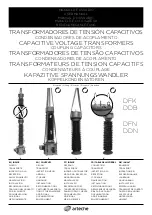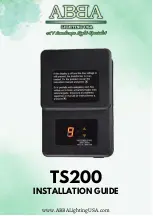
5.5
A pressure-over-range error condition will occur when the applied pressure is greater than or equal
to 1% of full scale (FS) above the FS limit. For example, if the pressure applied to a 20 psi unit is
•20.200 psi, then an over range error condition is set (see
RS
command). Similarly, an under range
condition occurs when the applied pressure is greater than or equal to 1%FS below the minimum
limit. To indicate an out-of-range condition (greater than ±1% FS), the equal ‘=’ sign will be replaced
by an exclamation point ‘!’ in the pressure reading reply. This indicator will disappear when the
applied pressure is in range, but the
RS
command error flag will continue to be set until it is cleared
by an inquiry.
The maximum reading will flatten out between 1% and 5% beyond the FS limit with increasing
pressure. This limit varies from device to device but will continue to display the out-of-range indica-
tor (“!” in place of “=“) until the pressure drops below 1% over FS limit.
ASCII FORMAT REPLIES
Most commands use the ASCII format reply and may be identified by the header character (ASCII –
American Standard for Coded Information Interchange). The ASCII format consists of standard
keyboard alpha-numeric characters and symbols. The
header character
is the first character in the
reply from the PPT. The ASCII format information request reply uses the following header charac-
ters:
#
ASCII format reply from an assigned address PPT.
?
ASCII format reply from a null address PPT.
Example replies to command code (cc) are: (where xx = the parameter value)
#ddcc=xx
reply from unit with an assigned address (dd).
#ddcc!xx
reply from unit with an assigned address (dd) when 1) pressure or temperature
reading is out-of-range (over/under limit = ±1%FS) or, 2) an EEPROM parity error
has occurred (pressure reading will output zero).
#ddcc=..
reply from unit with an assigned address (dd) when data is not available yet from the
PPT or the output was disabled (see
DA
command). Request again.
?ddcc=xx
reply from a null address unit (dd).
?ddcc!xx
reply from a null address unit (dd) when 1) pressure or temperature reading is out-of-
range (over/under limit = ±1%FS) or, 2) an EEPROM parity error has occurred
(pressure reading will output zero).
?ddcc=..
reply from a null address unit (dd) when data is not available yet from the PPT or the
output was disabled (see
DA
command). Request again.
Note:
For multidrop bus mode alternate header descriptions see
MO
command description.
3 0
















































